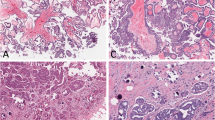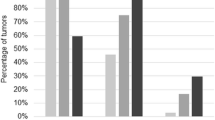Abstract
The pathogenesis of ovarian carcinomas is heterogeneous, with even the same entities showing great variance. In our study we investigated the mutations of the BRAF, KRAS, and p53 genes in serous and mucinous borderline tumors and in low grade and high grade serous and mucinous tumors. The mutations of BRAF and KRAS genes have been shown in 60% of borderline and low grade (well differentiated) serous and mucinous tumors, but very rarely in high grade (moderately and poorly differentiated) carcinomas. However mutations of p53 are very common in high grade tumors and this indicates a "dualistic" model of ovarian tumorigenesis. A total of 80 serous tumors, including serous borderline, low grade and high grade tumors, and 23 mucinous tumors, including borderline and invasive tumors were analysed for BRAF and KRAS mutations using real time PCR method followed by melting point analysis. P53 mutation was investigated by immunohistochemistry. We assumed mutation of the p53 gene when 100% of tumor cells showed strong nuclear positivity. We observed differences in genetic alterations in the development of the low grade tumors and between low and high grade tumors too. In some bilateral or stage II-III cases we observed differences between the mutation status of the left and right ovarian tumors and between the primary tumor and its implants. In one case in a tumor with micropapillary pattern showing high grade nuclear atypia we could detect mutations in both KRAS and p53 genes. The majority of our mucinous ovarian tumor cases showed a KRAS mutation. We have not found mutations of the BRAF and p53 genes in these cases. We have found as have others, that there is a dualistic pathway of ovarian carcinogenesis. In the majority of cases, low grade epithelial tumors develop in a stepwise manner due to genetic alterations of the members of MAP-kinase pathway; however mutation of the p53 gene is the key event in the development of high grade tumors.



Similar content being viewed by others
References
FIGO. Intenational Federation of Gynecology and Obstetrics (1971) Classification and staging of malignant tumours in the female pelvis. Acta Obstet Gynecol Scand 50:1–7
Serov SF, Scully RE, Sobin LH (1973) International histologic Classification of Tumours. No. 9. Histological Typing of Ovarian Tumours. World Health Organization, Geneva
Österbeerg L, Akeson M, Levan K et al (2006) Genetic alterations of serous borderline tumors of the ovary compared to stage I serous ovarian carcinomas. Cancer Genet Cytogenet 167:103–108
Singer G, Oldt R, Cohen Y et al (2003) Mutations in BRAF and KRAS characterize the development of low-grade ovarian serous carcinoma. J Natl Cancer Inst 95:484–486
Singer G, Stöhr R, Cope L et al (2005) Patterns of p53 mutations separate ovarian serous borderline tumors and low —and high-grade carcinomas and provide support for a new model of ovarian carcinogenesis (A mutational analysis with immunohistochemical correlation). Am J Surg Pathol 29(2):218–224
Hsu C-Y, Bristow R, Cha M et al (2004) Characterization of active mitogen-activated protein kinase in ovarian serous carcinomas. Clin Cancer Res 10:6432–6436
Staebler A, Diebold J (2007) Molekularpathologie der epithelialen Ovarialneoplasien (Von der Phänotyp-Genotyp-Korrelation zu neuen Ansatzpunkten in Diagnostik und Therapie). Pathologe 28:180–186
Ho C-L, Kurman RJ, Dehari R et al (2004) Mutations of BRAF and KRAS precede the development of ovarian serous borderline tumors. Cancer Res 64:6915–6918
Shih I-M, Kurman RJ (2004) Ovarian tumorigenesis (Review). Am J Path 164(5):1511–1518
Kurman RJ, Shih I-M (2008) Pathogenesis of ovarian cancer. Lessons from morphology and molecular biology and their implications. Int J Gynecol Pathol 27(2):151–160
Seidman JD, Horkayne-Szakaly I, Haiba M et al (2004) The histologic type and stage distribution of ovarian carcinomas of surface epithelial origin. Int J Gynecol Pathol 23:41–44
Hart WR (2005) Borderline epithelial tumors of the ovary. Mod Path 18:33–50
Bell DA (2005) Origins and molecular pathology of ovarian cancer. Mod Pathol 18:S19–S32
Christie M, Oehler MK (2006) Molecular pathology of epithelial ovarian cancer. J Br Menopause Soc 12(2):57–63
Singer G, Kurman RJ, Chang H-W et al (2002) Diverse tumorigenic pathways in ovarian serous carcinoma. Am J Pathol 160:1223–1228
Shih I-M, Kurman RJ (2005) Molecular pathogenesis of ovarian borderline tumors: new insight and old challenges. Clin Cancer Res 11:7273–7279
Sridhar SS, Hedley D, Siu LL (2005) Raf kinase as a target for anticancer therapeutics. Mol Cancer Ther 4(4):677–685
Pohl G, Ho C-L, Kurman RJ (2005) Inactivation of the Mitogen-Activared Protein Kinase pathway as a potential target-based therapy in ovarian serous tumors with KRAS or BRAF mutations. Cancer Res 65(5):1994–2000
Sieben NLG, Macropoulos P, Roemen GMJM et al (2004) In ovarian neoplasms BRAF, but not KRAS, mutations are restricted to low-grade serous tumours. J Pathol 202:336–340
Mayr D, Hirschmann A, Löhrs U et al (2006) KRAS and BRAF mutations in ovarian tumors: A comprehensive study of invasive carcinomas, borderline tumors and extraovarian implants. Gynecol Oncol 103:883–887
Ueda M, Toji E, Noda S (2007) Germ line and somatic mutations of BRAF V599E in ovarian carcinoma. Int J Gynecol Cancer
Wang L, Arnold K (2003) Common mutations prevalent in low-grade ovarian cancers. J Nat Cancer Inst 95(6):417–418
Garrett AP, Lee KP, Colitti CR et al (2001) K-RAS mutation may be an early event in mucinous ovarian tumorigenesis. Int J Gynecol Pathol 20:244–251
Vang R, Shih I-M, Salani R et al (2008) Subdividing ovarian and peritoneal serous carcinoma into moderately differentiated and poorly differentiated does not have biologic validity based on molecular genetic and in vitro drug resistance data. Am J Surg Pathol 32(11):1667–1674
Köbel M, Hunstman D, Gilks CB (2008) Critical molecular abnormalities in high grade serous carcinoma of the ovary. Expert Rev Mol Med 10:e22
Russell SEH, McCluggage WG (2004) A multistep model for ovarian tumorigenesis: the value of mutation analysis in the KRAS and BRAF genes. L Pathol 203:617–619
Lee Y, Miron A, Drapkin R et al (2007) A candidate precursor to serous sarcinoma that originates in the distal fallopian tube. J Pathol 211(1):26–35
Goodman MT, Shvetsov YB (2009) Incidence of ovarian, peritoneal, and fallopian tube carcinomas in the United States, 1995–2004. Cancer Epidemiol Biomarkers Prev 18(1):132–139
Tong G-X, Chiriboga L, Hamele-Bena D et al (2007) Expression of PAX2 in papillary serous carcinoma of the ovary: immunohistochemical evidence of fallopian tube or secondary Müllerian system origin? Mod Pathol 20:856–863
Roh MH, Kindelberger D, Crum CP (2009) Serous tubal intraepithelial carcinoma and dominant ovarian mass: clues to serous tumor origin? Am J Surg Pathol 33(3):376–383
Leiato MM, Soslow RA, Baergen RN et al (2004) Mutation and expression of the TP53 gene in early stage epithelial ovarian carcinoma. Gynecol Oncol 93:301–306
Morice P, Uzan C, Kane A et al (2009) Prognostic factors of patients with advanced stage serous borderline tumors of the ovary. J Clin Oncol 27:15s (suppl;abstr 5573)
Sieben NL, Roemen GMJM, Oosting J (2006) Clonal analysis favours a monoclonal origin for serous borderline tumours with peritoneal implants. J Pathol 210:405–411
Krishnamurti U, Sasatomi E, Swalsky PA (2005) Microdissection-based mutational genotyping of serous borderline tumors of the ovary. Int J Gynecol Pathol 24:56–61
Diebold J, Seemuller F, Lohrs U (2003) K-RAS mutations in ovarian and extraovarian lesions of serous tumors of borderline malignancy. Lab Invest 83:251–258
Zanotti KM, Hart WR, Kennedy AW (1999) Allelic imbalance on chromosome 17p13 in borderline (low malignant potential) epithelial ovarian tumors. Int J Gynecol Pathol 18:247–253
Gu J, Roth LM, Younger C et al (2001) Molecular evidence for the independent origin of extraovarian papillary serous tumors of low malignant potential. J Natl Cancer Inst 93:1147–1152
Lu KH, Bell DA, Welch WR et al (1998) Evidence for the multifocal origin of bilateral and advanced human serous borderline ovarian tumors. Cancer Res 58:2328–2330
Davies H, Bignell GR, Cox C et al (2002) Mutations of BRAF gene in human cancer. Nature 417:949–954
Cheng EJ, Kurman RJ, Wang M et al (2004) Molecular genetic analysis of ovarian serous cystadenomas. Lab Invest 84:778–784
Burks RT, Sherman ME, Kurman RJ (1996) Micropapillary serous carcinoma of the ovary: a distinctive low-grade carcinoma related to serous borderline tumors. Am J Surg Pathol 20:1319–1330
Acknowledgements
We are indebted to Professor Charles E Connolly for reviewing and correcting the paper.
This study was supported by grants of the EEA and Norwegian Financial Mechanisms in Hungary, Development of joint Hungarian and Norwegian strategy for cancer treatment by molecular methods. (Prevention, early diagnosis and therapy) No. 107/2008/NA and the Project co-financed by the European Social Fund through the Sectoral Operational Programme Human Resources Development 2007–2013. Project title: Advanced Research through postdoctoral programmes in fundamental and clinical medical sciences. Contract Code: POSDRU/89/1.5/S/60782
Author information
Authors and Affiliations
Corresponding author
Rights and permissions
About this article
Cite this article
Vereczkey, I., Serester, O., Dobos, J. et al. Molecular Characterization of 103 Ovarian Serous and Mucinous Tumors. Pathol. Oncol. Res. 17, 551–559 (2011). https://doi.org/10.1007/s12253-010-9345-8
Received:
Accepted:
Published:
Issue Date:
DOI: https://doi.org/10.1007/s12253-010-9345-8




